6172RB Science a STEM approach Year 2 low res watermark
You also want an ePaper? Increase the reach of your titles
YUMPU automatically turns print PDFs into web optimized ePapers that Google loves.
Earth and space sciences<br />
OUR RESOURCEFUL WORLD<br />
Lesson 2<br />
Lesson plan<br />
Introduction:<br />
1. Divide the class into groups of six and give each group a pad of sticky notes. Ask students What<br />
food products do we eat or use? As a group, students think of as many different food products as<br />
possible and record each one on a separate sticky note. After two minutes, display the mini poster,<br />
‘What food products do we eat or use?’ on page 84 and encourage students to add more ideas to<br />
their sticky notes. Stop the students after a few minutes. QP PA<br />
2. As a group, students decide which of Earth’s <strong>res</strong>ources we get food from (plants and animals). Ask<br />
students to sort the food items recorded on their sticky notes into two groups—food from plants<br />
and food from animals. QP PA<br />
Development:<br />
3. Using a think-pair-share, ask students How do different foods get from their natural environment to<br />
our homes? Share their ideas. QP<br />
4. In groups of three, assign students a product for them to role-play how the product gets from the<br />
farm to their fork. Students need to decide on three basic steps for each of them to role-play; i.e.<br />
farmer picks apple, worker juices apple, shop sells it. Suggested simple food products are apple<br />
juice, potato chips, banana bread, cereal, cheese, fruit salad and peanut butter. QP PC PA<br />
5. Divide the class into eight groups and give each group one iPad® with a QR scanner on it and<br />
one pre-prepared card from page 85. Using an A3 piece of paper folded in half, students copy<br />
one question from their pre-prepared card onto each half of the page. Under the first question,<br />
students work as a team to brainstorm and record examples of Earth’s <strong>res</strong>ources that we use for<br />
certain food products. Students then discuss the second question and scan a QR code to watch<br />
a video showing how a specific food gets from a farm to your house. Students discuss the steps<br />
described during the video, to choose and record, using words or images, five main stages in<br />
the production of their given food. Note: These videos were produced in the United Kingdom by<br />
Tesco as part of the Food to fork series. For this reason, it is recommended that students are taught<br />
that these processes are used in many countries around the world, including Australia.<br />
QP PC PA<br />
Differentiation<br />
• Less capable students may be encouraged to draw images of different food products or<br />
contribute orally to mixed-ability groupings. Alternatively, they may be grouped together and<br />
assisted by an adult.<br />
• More capable students may be encouraged to write explanations for each step of the process.<br />
6. Pair a group that <strong>res</strong>earched food products from animals with a group that <strong>res</strong>earched food<br />
products from plants. When paired, each group takes a turn to read each question and share the<br />
information recorded on their piece of paper with the other group. E<br />
Reflection:<br />
7. Using a think-pair-share, one student explains how food products that come from animals get<br />
from a source (their environment) to our supermarkets and subsequently to our houses. The<br />
other student must listen and clarify misunderstandings. Students swap roles to explain how food<br />
products that come from plants get to our supermarkets and houses. E C<br />
© R.I.C. Publications<br />
Low <strong>res</strong>olution display copy<br />
R.I.C. Publications® – www.ricpublications.com.au 978-1-925431-95-7 YEAR <strong>Science</strong>:<br />
2 A <strong>STEM</strong> APPROACH 83


















